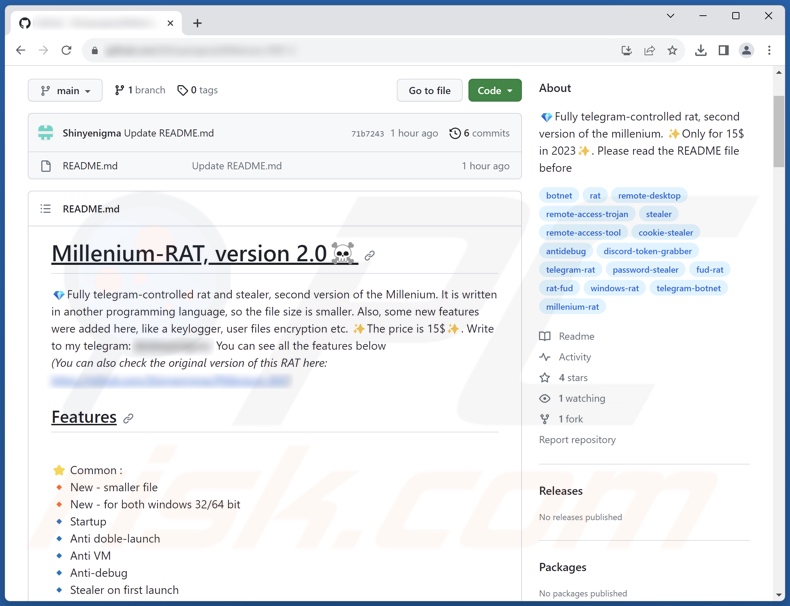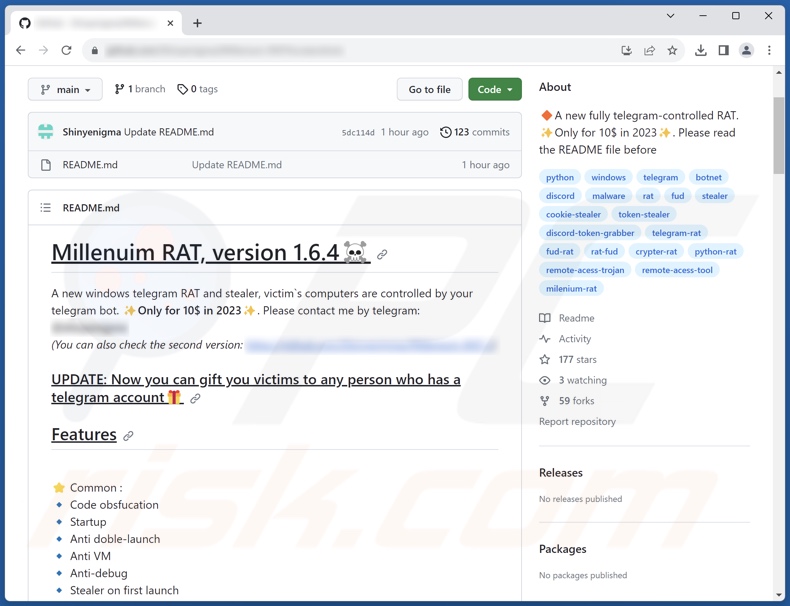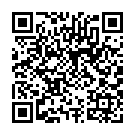Removal instructions for the Millenium remote access trojan
![]() Written by Tomas Meskauskas on
Written by Tomas Meskauskas on
What kind of malware is Millenium?
Millenium malware is a Remote Access Trojan (RAT). Programs categorized as such are designed to enable attackers to have remote access and control over infected machines. RATs tend to be highly versatile, and Millenium is not an exception. It can execute various commands on compromised devices, and this trojan has extensive data-stealing capabilities.

Millenium malware overview
At the time of writing, there are two variants of Millenium offered for sale on the Web. To elaborate on their functionalities and features, both operate as multifunctional RATs – i.e., enabling remote access/control over infected systems. Millenium implements obfuscated code as an anti-detection measure. Its anti-analysis mechanisms include detection when the malware is launched on a virtual machine and anti-debugging features.
Millenium gathers relevant device data, e.g., CPU, GPU, RAM, IP address (geolocation), MAC address, etc. The trojan can also restart and shut down the system and even invoke the Blue screen of death error. It collects information relating to running processes and their paths. The program can terminate processes as well.
Millenium is capable of managing folders and files; it can copy, delete, download, upload, and perform other actions with said content. Taking screenshots is likewise among Millenium's abilities.
The RAT can extract data from browsers (listed below), including bookmarks, Internet cookies, usernames/passwords, and credit card numbers. Millenium also targets information associated with the Discord and Telegram messaging platforms.
The latest version of this RAT (Millenium 2.0) has all of the aforementioned functionalities. New additions include obtaining a list of installed software and active window data. This variant is capable of minimizing/maximizing windows and putting the system into sleep mode.
It has keylogging abilities, i.e., the program can record keystrokes (keyboard input/ typed information). Millenium's file is also smaller in size, which aids in detection evasion.
It is worth noting that potential future iterations of Millenium could have additional/different capabilities and features.
To summarize, the presence of malicious software like Millenium on devices may lead to data loss, severe privacy issues, financial losses, and identity theft.
| Name | Millenium remote access trojan |
| Threat Type | Trojan, remote access trojan (RAT), password-stealing virus, banking malware, spyware. |
| Symptoms | Trojans are designed to stealthily infiltrate the victim's computer and remain silent, and thus no particular symptoms are clearly visible on an infected machine. |
| Distribution methods | Infected email attachments, malicious online advertisements, social engineering, software 'cracks'. |
| Damage | Stolen passwords and banking information, identity theft, the victim's computer added to a botnet. |
| Malware Removal (Windows) | To eliminate possible malware infections, scan your computer with legitimate antivirus software. Our security researchers recommend using Combo Cleaner. |
Remote access trojan examples
ZenRAT, ValleyRAT, Aphrobyte Plus, PySilon, Loda, and SuperBear are just some examples of RATs that we have written about recently.
Generally, remote access trojans are incredibly multifunctional. However, this can be true for any type of malware. While some malicious programs have narrowly tailored purposes, others can be used in a wide variety of ways.
Yet regardless of how malware operates – its presence on a system is a threat to device integrity and user privacy as well as safety. Therefore, all threats must be removed immediately upon detection.
How did Millenium infiltrate my computer?
Millenium has been observed being promoted on GitHub as a purchasable tool. Hence, how this RAT is proliferated depends on the cyber criminals using it.
Phishing and social engineering techniques are commonly implemented in malware distribution. Malicious programs are typically disguised as or bundled with ordinary software/media files. They can be executables (.exe, .run, etc.), archives (RAR, ZIP, etc.), documents (Microsoft Office, Microsoft OneNote, PDF, etc.), JavaScript, and so on.
The most widely used malware proliferation methods include: drive-by (stealthy/deceptive) downloads, malicious attachments/links in spam mail (e.g., emails, PMs/DMs, SMSes, etc.), online scams, malvertising, dubious download channels (e.g., freeware and free file-hosting websites, P2P sharing networks, etc.), fake updaters, and illegal software activation ("cracking") tools.
Furthermore, some malicious programs can self-spread through local networks and removable storage devices (e.g., external hard drives, USB flash drives, etc.).
How to avoid installation of malware?
It is essential to download only from official and verified sources. We recommend activating and updating software by using legitimate functions/tools, as those obtained from third-parties can contain malware.
Another recommendation is to be careful while browsing since fraudulent and malicious online content typically appears genuine and harmless. We advise exercising caution with incoming emails and other messages. Attachments or links present in dubious mail must not be opened, as they can be infectious.
It is paramount for device/user safety to have a reputable anti-virus installed and kept updated. Security programs must be used to perform regular system scans and to remove threats and issues. If you believe that your computer is already infected, we recommend running a scan with Combo Cleaner Antivirus for Windows to automatically eliminate infiltrated malware.
Screenshot of the previous version of Millenium RAT promoted on GitHub:

List of browsers targeted by Millenium RAT (including but not limited to):
- Google Chrome
- Microsoft Edge
- 7Star
- Amigo
- Brave
- CentBrowser
- Chrome SxS
- Cometa
- Iridium
- Opera
- Opera GX
- Orbitum
- Sputnik
- Torch
- Uran
- Vivaldi
- Yandex
Instant automatic malware removal:
Manual threat removal might be a lengthy and complicated process that requires advanced IT skills. Combo Cleaner is a professional automatic malware removal tool that is recommended to get rid of malware. Download it by clicking the button below:
▼ DOWNLOAD Combo Cleaner
By downloading any software listed on this website you agree to our Privacy Policy and Terms of Use. To use full-featured product, you have to purchase a license for Combo Cleaner. 7 days free trial available. Combo Cleaner is owned and operated by Rcs Lt, the parent company of PCRisk.com read more.
Quick menu:
- What is Millenium?
- STEP 1. Manual removal of Millenium malware.
- STEP 2. Check if your computer is clean.
How to remove malware manually?
Manual malware removal is a complicated task - usually it is best to allow antivirus or anti-malware programs to do this automatically. To remove this malware we recommend using Combo Cleaner Antivirus for Windows.
If you wish to remove malware manually, the first step is to identify the name of the malware that you are trying to remove. Here is an example of a suspicious program running on a user's computer:

If you checked the list of programs running on your computer, for example, using task manager, and identified a program that looks suspicious, you should continue with these steps:
 Download a program called Autoruns. This program shows auto-start applications, Registry, and file system locations:
Download a program called Autoruns. This program shows auto-start applications, Registry, and file system locations:

 Restart your computer into Safe Mode:
Restart your computer into Safe Mode:
Windows XP and Windows 7 users: Start your computer in Safe Mode. Click Start, click Shut Down, click Restart, click OK. During your computer start process, press the F8 key on your keyboard multiple times until you see the Windows Advanced Option menu, and then select Safe Mode with Networking from the list.

Video showing how to start Windows 7 in "Safe Mode with Networking":
Windows 8 users: Start Windows 8 is Safe Mode with Networking - Go to Windows 8 Start Screen, type Advanced, in the search results select Settings. Click Advanced startup options, in the opened "General PC Settings" window, select Advanced startup.
Click the "Restart now" button. Your computer will now restart into the "Advanced Startup options menu". Click the "Troubleshoot" button, and then click the "Advanced options" button. In the advanced option screen, click "Startup settings".
Click the "Restart" button. Your PC will restart into the Startup Settings screen. Press F5 to boot in Safe Mode with Networking.

Video showing how to start Windows 8 in "Safe Mode with Networking":
Windows 10 users: Click the Windows logo and select the Power icon. In the opened menu click "Restart" while holding "Shift" button on your keyboard. In the "choose an option" window click on the "Troubleshoot", next select "Advanced options".
In the advanced options menu select "Startup Settings" and click on the "Restart" button. In the following window you should click the "F5" button on your keyboard. This will restart your operating system in safe mode with networking.

Video showing how to start Windows 10 in "Safe Mode with Networking":
 Extract the downloaded archive and run the Autoruns.exe file.
Extract the downloaded archive and run the Autoruns.exe file.

 In the Autoruns application, click "Options" at the top and uncheck "Hide Empty Locations" and "Hide Windows Entries" options. After this procedure, click the "Refresh" icon.
In the Autoruns application, click "Options" at the top and uncheck "Hide Empty Locations" and "Hide Windows Entries" options. After this procedure, click the "Refresh" icon.

 Check the list provided by the Autoruns application and locate the malware file that you want to eliminate.
Check the list provided by the Autoruns application and locate the malware file that you want to eliminate.
You should write down its full path and name. Note that some malware hides process names under legitimate Windows process names. At this stage, it is very important to avoid removing system files. After you locate the suspicious program you wish to remove, right click your mouse over its name and choose "Delete".

After removing the malware through the Autoruns application (this ensures that the malware will not run automatically on the next system startup), you should search for the malware name on your computer. Be sure to enable hidden files and folders before proceeding. If you find the filename of the malware, be sure to remove it.

Reboot your computer in normal mode. Following these steps should remove any malware from your computer. Note that manual threat removal requires advanced computer skills. If you do not have these skills, leave malware removal to antivirus and anti-malware programs.
These steps might not work with advanced malware infections. As always it is best to prevent infection than try to remove malware later. To keep your computer safe, install the latest operating system updates and use antivirus software. To be sure your computer is free of malware infections, we recommend scanning it with Combo Cleaner Antivirus for Windows.
Frequently Asked Questions (FAQ)
My computer is infected with Millenium malware, should I format my storage device to get rid of it?
Most malicious programs can be removed without formatting.
What are the biggest issues that Millenium malware can cause?
The threats depend on the malware's capabilities and the cyber criminals' modus operandi. Millenium is a highly versatile RAT – it enables remote access/control over machines and has extensive data-stealing abilities. Generally, infections of this kind can lead to data loss, serious privacy issues, financial losses, and identity theft.
What is the purpose of Millenium malware?
Most malware infections are geared towards financial gain. However, malicious software can also be used to amuse cyber criminals or disrupt processes (e.g., websites, services, companies, organizations, etc.). Attacks can be motivated by personal grudges, hacktivism, and political/geopolitical reasons.
How did Millenium malware infiltrate my computer?
Malware is predominantly distributed via drive-by downloads, online scams, spam emails/messages, untrustworthy download sources (e.g., freeware and third-party sites, P2P sharing networks, etc.), illegal program activation tools ("cracks"), fake updates, and malvertising. Some malicious programs can even self-proliferate through local networks and removable storage devices.
Will Combo Cleaner protect me from malware?
Yes, Combo Cleaner is designed to scan systems and remove threats. It can detect and eliminate nearly all known malware infections. Note that running a complete system scan is crucial since sophisticated malicious programs typically hide deep within systems.


▼ Show Discussion